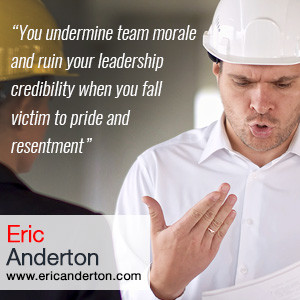Allegheny Mound Ants range in North America from Nova Scotia in the North to Georgia in the South. They are well known for building mounds at the rate of 1 foot per year. The typical mound is about 10 feet high, it takes a decade of work to build their homes, an incredible commitment of time.
Just like it takes time for the ants to build their mounds, so it takes time for leaders to build relationships with the people they lead. Here are three simple ways to do that:
- Notice their Strengths
- Say “Good Morning”
- Sacrifice
First let’s consider: Notice their Strengths
You are well aware of the faults of your direct reports
Construction is a tough, risky, conflict filled business. If you are like many of the contractors that I work with, you tend to be a pretty cautious and skeptical person. You quickly form negative opinions of others when you see their faults, and at times that effects your ability to build relationships.
Make a list of the people that report to you.
Ignore their weaknesses for a moment, and make note of one of their strengths. Then commit to noticing them demonstrating that strength. The gives you an opportunity to reframe your natural critical perspective, and focus on “the good” in your direct reports.
With their strengths in mind you can move to the next step of building relationships: Say “Good Morning”
Winston Churchill, the Prime Minister of Britain during World War II, was famous for taking risks.
As a young solider he actively sought combat assignments. That daring stayed with him throughout his life. Shortly after the Allied invasion of Europe, in June 1944, he left the safety of England, hopped on a military aircraft, and visited the troops in France. Churchill was a master communicator, and gave special attention to making personal connections with individual soldiers. He did this by focusing on two things: thanking them for their combat commitment, and inquiring into their welfare and personal circumstances. He was willing to undergo this hazardous trip, putting himself near the front lines, because he knew that visiting and speaking to the troops would deeply encourage them.
It’s easy to get caught up in the whirlwind of daily activity and neglect your relationships with your direct reports.
The final step you can take to build relationships is: Sacrifice
Think about the last time you made a bad call on a project
How long did it take you to humble yourself admit that you were wrong and do something to fix it? What about when one of your direct reports screwed up? Perhaps one of your project managers failed to keep a schedule commitment and that cost you a bunch of money. Or, an estimator put a ton of time and resources into a bid, assured you that it was in the bag, only to find out the owner gave the work your fiercest competitor. Did their mistakes cause you to resent them?
You sacrifice your pride by simply apologizing when you make a wrong decision. You don’t have to grovel, or justify yourself, simply say “I was wrong, I apologize, here’s what I’m going to do to fix it.”
Overcome resentment by framing every experience as a learning opportunity.
Instead of being bitter when one of your people blows it, allow the experience to instruct you. Thinking back to your project manager who failed to meet the schedule or the estimator that lost out on the sweet opportunity. What does their failure tell you about where they need to be trained or held accountable? What have you learned about the quality of your processes or the depth of your relationships with your clients? You have a great deal of freedom to choose how and with whom you work. Let that sense of freedom guide your decisions and keep you from allowing resentment to build up towards your team.
Persistent, long-term action yields results
Take a lesson from the Allegheny Mound Ants, who labor for years to construct their mounds. It takes time and commitment to build relationships with your people. There are ups and downs along the way and that’s exactly why it’s important that you focus your leadership energies on these simple steps: Notice the good, say “good morning”, and sacrifice
As you implement these suggestions, you might be pleasantly surprised by the positive impact on your people’s morale and productivity.
Leadership is a life-long challenge
This article may have exposed for you some opportunities for improvement in your leadership. I have developed a simple tool to help you figure out and focus on what matters the most in your leadership role. It’s called The Construction Leadership Dashboard. Get started today, improving your leadership, click this link to download the dashboard.




